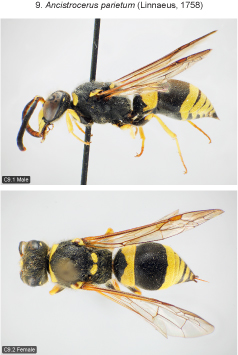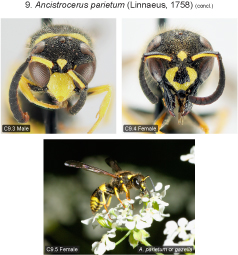
| Home | Table of contents | Keys | Species list | Glossary | Image data | PDF | Cite this article | Feedback | Updates |
Identification Atlas of the Vespidae (Hymenoptera, Aculeata) of the northeastern Nearctic region
CJAI 05, February 19, 2008
doi: 10.3752/cjai.2008.05
Matthias Buck, Stephen A. Marshall, and David K.B. Cheung
Department of Environmental Biology, University of Guelph, Guelph, Ontario, Canada N1G 2W1
Next species | Previous species | Key
9. Ancistrocerus parietum (Linnaeus, 1758)
Figs B2.19; B3.8, 39; C9.1–5.

|

|
Species recognition. This species is similar to A. gazella (diagnostic characters given under that species).
Variation. Fore wing length 6.5–8.0 mm (♂♂), 7.5–10.0 mm (♀♀). Humeral angle of pronotum hardly produced in female; in male sometimes produced slightly beyond level of anterior margin of pronotum and more or less curved outward. Female clypeus usually yellow with a central black spot extending to dorsal margin of clypeus, sometimes also extending to ventrolateral margin of each side; rarely clypeus black with a pair of large yellow dorsal spots and a smaller pair of ventral spots. Yellow spot along inner orbit elongate or reduced to small spot in male, in female a small spot usually present. Yellow pronotal band occupying approximately anterior 1/3–2/5 of pronotum. Spot on upper mesopleuron large, small or absent in female; usually absent in male, if present small. Parategula black. Pair of yellow scutellar spots large and usually narrowly separated in female; large, small or absent in male. Metanotum with two or more, irregular, often evanescent spots or completely black. Metasomal terga 1–5 fasciate, tergum 6 of female almost always with a yellow preapical spot. Sterna 1–5 in female 1–(5)6 in male fasciate; fascia of sternum 1 sometimes obscure; fasciae emarginate; fascia of sternum 5 interrupted laterally in female, usually interrupted on 6 and sometimes on 5 in male.
Distribution. Canada: ON, QC, newly recorded from NF (photographic record, Bugguide), NS, MB and SK. Eastern U.S.: MA to DC, west to OH and MI (Krombein 1979). Native to Palaearctic: from Europe and Northwest Africa to Manchuria, also Madeira (Gusenleitner 1995). This Palaearctic species was found for the first time in North America in 1916 (NY: Ithaca; cf. Bequaert 1925). The oldest Canadian specimen examined by us was collected in 1917 (QC: 1 ♂, Outremont; LEMQ), a decade earlier than the oldest previously published records from 1928 (QC: “Kamour Co.” [= Kamouraska?] and Montreal; cf. Bequaert 1944a).
Biology. Nests in crevices in mortar or rock, tree stumps, and burrows in clay banks. Preys on caterpillars (Tortricidae recorded from Ontario), in Europe rarely also on Melasoma (Chrysomelidae) larvae (Krombein 1979).
Next species | Previous species | Key
| Home | Table of contents | Keys | Species list | Glossary | Image data | PDF | Cite this article | Feedback | Updates |
